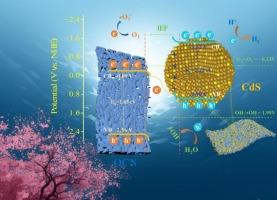CdS量子点/氧掺杂g-C3N4 z -图式异质结的光催化:揭示量子约束效应、缺陷工程和z -图式机理的协同效应
IF 13.2
1区 工程技术
Q1 ENGINEERING, CHEMICAL
引用次数: 0
摘要
聚合物氮化碳(g-C3N4)作为一种新兴的可见光响应半导体光催化剂,在太阳能转换技术中引起了广泛的研究兴趣。然而,它的实际实施面临着严峻的挑战,包括有限的光收集能力和低效的载流子动力学,这大大降低了光催化效率。为了解决这些限制,我们提出了一种新的Z-scheme异质结(表示为OCN/CdS),通过战略性地将硫化镉量子点(CdS QDs)与缺陷工程氧掺杂g-C3N4纳米片(OCN)集成。所设计的体系结构集成了CdS量子点的量子约束效应、OCN中定制的缺陷态以及通过Z-scheme电荷转移途径增强的界面电场。优化后的OCN/CdS-2异质结具有较强的光催化活性,四环素降解率(kapp)为0.031 min−1,析氢率为5270 μmol·g−1·h−1。与原始g-C3N4相比,这些值分别对应3.4倍和21倍的改进。机理研究表明,OCN/CdS-2 Z-scheme异质结同时最大化活性位点暴露,并在界面处建立强大的内置电场,共同抑制电荷重组,同时加速氧化还原反应动力学。本文提出了一种通过多维结构工程策略构建高性能g- c3n4型z型异质结的策略框架。本文章由计算机程序翻译,如有差异,请以英文原文为准。

Photocatalysis over CdS quantum dots/oxygen doped g-C3N4 Z-scheme heterojunction: Revealing the synergistic effects of quantum confinement effect, defect engineering, and Z-scheme mechanism
Polymeric carbon nitride (g-C3N4), as an emerging visible-light-responsive semiconductor photocatalyst, has attracted considerable research interest in solar energy conversion technologies. Nevertheless, its practical implementation faces critical challenges including restricted light-harvesting capacity and inefficient charge carrier dynamics, which substantially compromise photocatalytic efficiency. To address these limitations, we propose a novel Z-scheme heterojunction (denoted as OCN/CdS) by strategically integrating cadmium sulfide quantum dots (CdS QDs) with defect-engineered oxygen-doped g-C3N4 nanosheets (OCN). The designed architecture integrates quantum confinement effects from CdS QDs, tailored defect states in OCN, and interfacial electric field enhancement through Z-scheme charge transfer pathways. The optimized OCN/CdS-2 heterojunction exhibits enhanced photocatalytic activity, achieving a tetracycline degradation rate (kapp) of 0.031 min−1 and a hydrogen evolution rate of 5270 μmol·g−1·h−1. These values correspond to 3.4-fold and 21-fold improvements compared to pristine g-C3N4, respectively. Mechanistic investigations reveal that the OCN/CdS-2 Z-scheme heterojunction simultaneously maximizes active site exposure and establishes robust built-in electric fields at interfaces, which collectively suppress charge recombination while accelerating redox reaction kinetics. A strategic framework is proposed in this work for constructing enhanced-performance g-C3N4-based Z-scheme heterojunctions through multidimensional structural engineering strategies.
求助全文
通过发布文献求助,成功后即可免费获取论文全文。
去求助
来源期刊

Chemical Engineering Journal
工程技术-工程:化工
CiteScore
21.70
自引率
9.30%
发文量
6781
审稿时长
2.4 months
期刊介绍:
The Chemical Engineering Journal is an international research journal that invites contributions of original and novel fundamental research. It aims to provide an international platform for presenting original fundamental research, interpretative reviews, and discussions on new developments in chemical engineering. The journal welcomes papers that describe novel theory and its practical application, as well as those that demonstrate the transfer of techniques from other disciplines. It also welcomes reports on carefully conducted experimental work that is soundly interpreted. The main focus of the journal is on original and rigorous research results that have broad significance. The Catalysis section within the Chemical Engineering Journal focuses specifically on Experimental and Theoretical studies in the fields of heterogeneous catalysis, molecular catalysis, and biocatalysis. These studies have industrial impact on various sectors such as chemicals, energy, materials, foods, healthcare, and environmental protection.
 求助内容:
求助内容: 应助结果提醒方式:
应助结果提醒方式:


